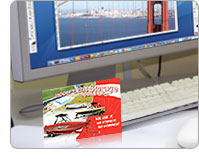- Products
-
Design Templates
- Featured Design Galleries
- More Galleries
- Services & Resources
- Free Sample Kit
- Deals
 It's not uncommon for folks to come away from the mailbox with a handful of mail nearly every day. When sifting through their mail, people mentally place each piece into an A pile, a B pile or a C pile. The A pile is mail that people want such as magazines, cards and letters. The B pile is for mail they don't want, but have to read such as bills, while the C pile is for brochures, flyers and direct mail. Unfortunately, most people plan on tossing the C pile into the trash on their way back to the house. That's why it's vital to create pieces that grab attention and beg to be read. There are several things you can do to ensure that your postcard, flyer or direct-mail piece stands out, in particular, using color combinations that'll make your mailers pop.
It's not uncommon for folks to come away from the mailbox with a handful of mail nearly every day. When sifting through their mail, people mentally place each piece into an A pile, a B pile or a C pile. The A pile is mail that people want such as magazines, cards and letters. The B pile is for mail they don't want, but have to read such as bills, while the C pile is for brochures, flyers and direct mail. Unfortunately, most people plan on tossing the C pile into the trash on their way back to the house. That's why it's vital to create pieces that grab attention and beg to be read. There are several things you can do to ensure that your postcard, flyer or direct-mail piece stands out, in particular, using color combinations that'll make your mailers pop.
Walk down the cleaning product aisle at the grocery store and take notice of how many products use the orange and blue color combination on their packaging. The reason this color combination is so widely used is because it's such a great attention grabber. In fact, it's probably the most used color combination in the marketing arena.
Like the orange and blue color combination, the use of red with green can also be widely found in marketing materials. While it doesn't offer the same amount of pop that blue with orange does, it's still a great combination that's sure to get attention. Many businesses that serve Italian food or products opt for the red/green combo to further brand themselves as Italian. Red can also be seen as fire, and green can be seen as earth, which makes a good combination for environmental pieces.
Black with yellow or orange color combos are used mainly around construction sites because workers want to draw attention to something - whether it's a danger area or a detour to take. Black with orange or yellow says "Look Here!"

Using the same color combination on your direct mailer or postcard will grab the same amount of attention. Consider creating a border with a striped black/yellow or orange design, or go for the maximum effect by putting black type against a yellow or orange background.
This set of complementary colors is also widely used in the marketing arena because it really grabs the eye. It's particularly useful for creating a sense of importance and elegance. All of these color combos are made up of complementary colors, which are colors opposite one another on the color wheel. They all consist of a light, warm color and a cold, dark color. In order to get the best effect, make sure your light color dominates the piece. That way the contrast of the cold color against the warm color creates a bigger impact and ensures that your mailer doesn't appear too dark.
Some people call them fluorescent, others call them neon. Regardless, these inks are so bright they really can hurt your eyes. If you've ever seen Wired magazine on the newsstand you know how well fluorescent inks stand out. A small fluorescent spot on a magazine cover can beam across the room and catch your eye. Imagine how well something that bright will stand out in a fistful of mail. The upside to using these inks is that people will look at your piece. The downside is that some people feel these inks are unprofessional looking and that the inks sole purpose is to grab the eye and not enhance the design. Choosing the right color combination for your next postcard or flyer can mean the difference between ending up getting read or tossed in the trash. These tips should make your quest for color a little easier.